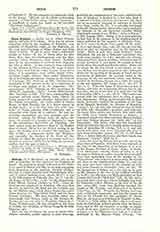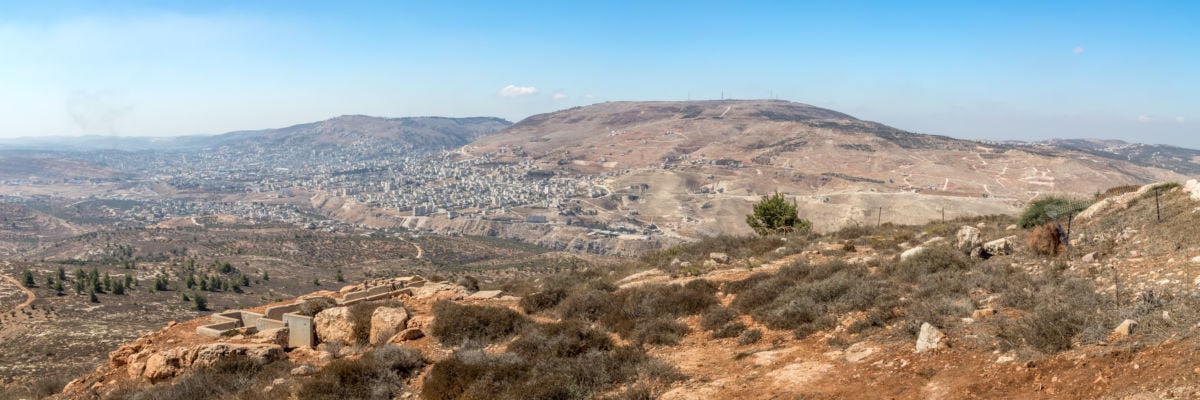

Sichem (Shechem), an Israelite city in the tribe of Ephraim, the first capital of the Kingdom of Israel. Its position is clearly indicated in the Bible: it lay north of Bethal and Silo, on the high road going from Jerusalem to the northern districts (Judges, xxi, 19), at a short distance from Machmethath (Jos., xvii, 7) and of Dothain (Gen., xxxvii, 12-17); it was in the hill-country of Ephraim (Jos., xx, 7; xxi, 21; III Kings, xii, 25; I Par., vi, 67; vii, 28), immediately below Mount Garizim (Judges, ix, 6-7). These indications are completed by Josephus, who says that the city lay between Mt. Ebal and Mt. Garizim, and by the Medaba map, which places Greek: Suchem, also called Sikima between the Tour Gobel (Ebal) and the Tour Garizin (Garizim). We may therefore admit unhesitatingly that Sichem stood on (St. Jerome, St. Epiphanius), or very close to (Eusebius, “Onomast.”, Suchem; Medaba map), the site occupied by the town of Nablils, the Neapolis, or Flavia Neapolis of early Christian ages.
That the city of Sichem, the name of which (Heb. 8U/am—shoulder, saddle) appears to have been suggested by the configuration of the place, existed in the time of Abraham is doubted by a few who think it is referred to in Gen., xii, 6, by anticipation; but there can be no question touching its existence in Jacob‘s time (Gen., xxxiii, 18, 19); it is certainly mentioned in the El-Amarna letters (letter 289), and is probably the Sakama of the old Egyptian traveller Mohar (fourteenth century B.C.; Muller, “Asien u. Europ.”, p. 394, Leipzig, 1893). Owing to its central position, no less than to the presence in the neighborhood of places hallowed by the memory of Abraham (Gen., xii, 6, 7; xxxiv, 5), Jacob (Gen., xxxiii, 18-19; xxxiv, 2, etc.), and Joseph (Jos., xxiv, 32), the city was destined to play an important part in the history of Israel. There it was that, after Gedeon‘s death, Abimelech, his son by a Sichemite concubine, was made king (Judges, ix, 1-6); but the city having, three years later, risen in rebellion, Abimelech took it, utterly destroyed it, and burnt the temple of Baalberith where the people had fled for safety. When and by whom the city was rebuilt is not known; at any rate, Sichem was the place appointed, after Solomon‘s death, for the meeting of the people of Israel and the investiture of Roboam; the meeting ended in the secession of the ten northern tribes, and Sichem, fortified by Jeroboam, became for a while the capital of the new kingdom (III Kings, xii, 1; xiv, 17; II Par., x, 1). When the kings of Israel moved first to Thersa, and later on to Samaria, Sichem lost its importance, and we do not hear of it until after the fall of Jerusalem (587 B.C.; Jer., xii, 5). The events connected with the restoration were to bring it again into prominence. When, on his second visit to Jerusalem, Nehemias expelled the grandson of the high priest Eliashib (probably the Manasse of Josephus, “Antiq.”, XI, vii, viii), who refused to separate from his alien wife, Sanaballat’s daughter, and with him the many Jews, priests and laymen, who sided with the rebel, these betook themselves to Sichem; a schismatic temple was then erected on Mount Garizim and thus Sichem became the “holy city” of the Samaritans. The latter, who were left unmolested while the orthodox Jews were chafing under the heavy hand of Antiochus IV (Antiq., XII, v, 5) and welcomed with open arms every renegade who came to them from Jerusalem (Antiq., XI, viii, 7), fell about 128 B.C. before John Hyrcanus, and their temple was destroyed (“Antiq.”, XIII, ix, 1).
From that time on, Sichem shared in the fate of the other cities of Samaria: with these it was annexed, at the time of the deposition of Archelaus, in A.D. 6, to the Roman Province of Syria. Some, no doubt, of its inhabitants (whether Sichar of John, iv, 5, is the same as Sichem or a place near the latter we shall leave here undecided) were of the number of the “Samaritans” who believed in Jesus when He tarried two days in the neighborhood (John, iv), and the city must have been visited by the Apostles on their way from Samaria to Jerusalem (Acts, viii, 25). Of the Samaritans of Sichem not a few rose up in arms on Mt. Garizim at the time of the Galilean rebellion (A.D. 67); the city was very likely destroyed on that occasion by Cerealis (“Bell. Jud.”, III, vii, 32), and a few years after a new city, Flavia Neapolis, was built by Vespasian a short distance to the west of the old one; some fifty years later Hadrian restored the temple on Mt. Garizim, and dedicated it to Jupiter (Dion Cass., xv, 12). Neapolis, like Sichem, had very early a Christian community and had the honor to give to the Church her first apologist, St. Justin Martyr; we hear even of bishops of Neapolis (Labbe,”Conc.”, I, 1475, 1488; II, 325). On several occasions the Christians suffered greatly from the Samaritans and in 474 the emperor, to avenge an unjust attack of the sect, deprived the latter of Mt. Garizim and gave it to the Christians who built on it a church dedicated to the Blessed Virgin (Procop. “Deaedif.”, v, 7). Since the Mohammedan conquest (636) Christianity, except during the twelfth century, has practically disappeared from Nablus, which, however, remains the headquarters of the Samaritan sect (about 150 members) and of their high priest.
CHARLES L. SOIIVAY


